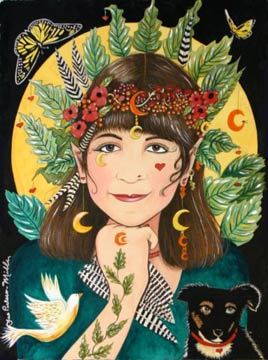
My capable mountain pony and I are following a barely discernible trail -- thank goodness for the lead horse's clearly visible tail -- through the wild mountain passes and lavender fields of Provence, in the south of France. Since morning we have been slowly wending our way up out of the valley and into the high mountain passes, through thickets of oak and pine which grow right to the edge of the trail.
It is difficult to convince her to turn aside -- and I am loathe to force the issue given the narrowness and the steepness of the trail -- so I just lean forward and plaster myself to my steed's neck as she makes her way under the low-hanging branches. Warmed by the bright sun, the pine needles exude a deep, resinous scent. It seems to fill my skull, leaving no room for the (literally) breath-taking views as we climb up along the mountain spine.
After hours of switch-backs -- and an ever-increasing intimacy with my horse's neck and the hazards of low branches -- we emerge into a natural clearing. With a rush of joy, and no trees to impede her, my mount flings herself into a gallop. We streak across a meadow densely tufted with low, purple-flowered thyme, and embroidered with stitches of rosemary and clover. On my left, in the far distance, snow-covered peaks rise (the Alps). On my right, far, far below, sequins of sunlight twinkle on an azure backdrop (the Mediterranean).
When our gallop is over, we stop. I close my eyes and inhale. I smell the actual scents of this mountain peak -- pine and thyme, stone and oak -- and I also smell, in memory, the scents of the flowering plants I have been riding through. Bowers of fragrant roses have scattered their petals across my shoulders (and scratched my arms). Honey-bee-buzzing linden trees heavy with honeyed flowers have brushed my face and left little remembrances in my hair as we clip-clopped across the village cobbles. Huge bushes of foamy-white, deliciously-perfumed elder blossoms have held out their witching arms and enticed me to pick them. The past, the future, and the present combine in one marvelous moment and I am filled with joy. Ah -- to be alive! How perfect! How glorious!
But what goes up usually comes down, and that is when the fun really begins. As my mountaineering friend Dolores La Chapelle used to remind me: "You can get up almost any mountain; it's getting down that's the problem." The path seems to fling itself off the edge of the world, and my horse follows. There's nothing but sky in front of me and the ground is terribly far below. (And though I am fairly certain that my mountain pony is in touch with the ground, I surely am not.) When I finally stop holding my breath, I realize the air is scented with some fragrance whose name I do not know. What is releasing such an alluring scent? Could it be this shrub with the arching masses of amazing yellow flowers? The mountainside is covered with it. It looks like scotch broom. "No," my guide informs me, "That is genet."
We are both right, of course. Genet is a kind of scotch broom (Cytisus). As such, it is a member of the bean family: A powerful earth-healing tribe of plants with the amazing ability to fix nitrogen, thus enriching the earth. The bean family (formerly known as the Leguminosa, but now called Fabaceae) includes healing plants such as red clover (Trifolium pratense) and astragalus (Astragalus membranaceous) -- both known as immune system builders and anti-cancer helpers -- and harmful plants such as loco weed and scotch broom, both of which are considered poisonous.
There is a lot to not like about scotch broom. Animals rarely eat it, and with good reason. It causes violent vomiting (emetic), copious urination (diuretic), and purging diarrhea (cathartic). As an herbal medicine it can be more troublesome than helpful. A few adventurous souls who have smoked the flowers confirm the hallucinatory properties of the plant. (And no gut-wrenching side effects; although it may increase the heart beat, sometimes alarmingly). Midwives have a special use for it, too. But most of us wisely leave this plant alone.
And that is her intention. I understand (and appreciate) scotch broom as an earth-healing plant. When trees are stripped from hillsides, whether by natural disaster or human need, the earth attempts to heal herself by growing special plants which have special healing abilities -- for Her, not us. In fact, one of the main ways these plants heal is by expelling, or, if possible, removing all animals (including humans) from the place that needs healing. Earth-healing plants are good for the earth but are often dangerous to us (even when possessing edible or medicinal parts). Some of the nicer ones include stinging nettle and brambles (including blackberry, raspberry, greenbriar, and wild rose). Some of the nastier ones include poison ivy/poison oak and rhododendrons (even the honey made from rhododendron flowers is poisonous).
Although native to Europe, Cytisus has made itself at home in the western United States, especially in clear-cut areas. It is generally considered invasive and obnoxious. The French version grows in the same situations (as we crossed the ridge and began our descent, we entered managed forests which are clear cut in rotation), but its fragrance sets it apart.
The odor of genet is spicy, sweet, and intoxicating. Its bright yellow pea-blossom-like flowers exude an aroma that can only be called "strong" -- not in a cloying sense, but in a penetrating way. The scent seems to permeate all my senses, inviting, no, urging me to enjoy life to the fullest.
As I rode, the smell of genet turned into a song. As my sure-footed pony walked, trotted, and cantered down the mountain a song burst out of my heart. I didn't feel like I was making it up; I felt like I was receiving it into my body. The words, the melody, the rhythm -- all partook of and gave out the sweetness and beauty of the plants, the mountains, the Earth. Verse after verse took shape and sounded its notes. Yet when I sat down that evening to commit it to paper, most of the verses were gone. I know where they went: the sun ate a bunch of them, and wind took some home to play with, and I left a few as a "thank you" gift to the mountains as well. Since I can't put a "scratch and sniff" in this magazine (and how I would love for you to be able to smell genet), here is my song. Enjoy!
Chorus: Genet, genet, you smell so sweet;
Genet you make my senses reel;
Genet, genet, you have
The sweetest smell.
The lavender that grows in rows,
It scents our clothes and things;
Has a smell gets up your nose,
But it's of genet I sing.
(Chorus)
The roses bloom in white and pink,
And every rose has thorns;
They have a smell that's not a stink,
But of genet I'll blow my horn.
(Chorus)
The irises they sure are fine
Their colors can't be beat
And they smell good all of the time
But let me now repeat.
(Chorus)
Phystoestrogens - Friends or Foe?
by Susun S. Weed
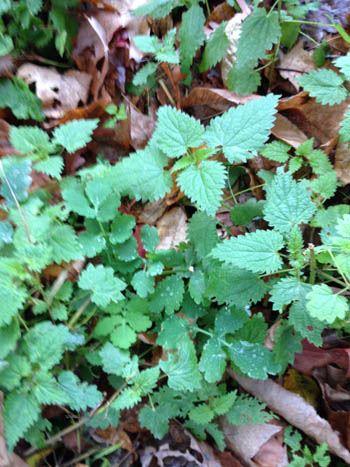
Phytoestrogens are weak hormones found in many plants. They are currently being promoted, sometimes in highly refined forms, for relief of the symptoms of menopause. Are they safe~ Can they promote breast cancer~
We know that increased exposure to hormones - such as those used in the cattle industry, those given to women during menopause, those taken by women engaged in hi-tech pregnancy efforts, and even those naturally produced by our own bodies - increases our risk of being diagnosed with cancer, especially breast cancer. And many believe that hormone-like chemicals - xenoestrogens - increasingly found in our food and water, contribute to cancer as well. Doesn't that imply that phytoestrogens will increase cancer risk too~
Virtually everything we eat - grains, beans, nuts, seeds, seed oils, berries, fruits, vegetables, and roots - contains phytoestrogens. Scientists measuring the amount of phytoestrogen break-down by-products in the urine of healthy women found that those with the least were four times more likely to be diagnosed with breast cancer than with the most. Phytoestrogens actually appear to protect tissues from the cancer-causing effects of xenoestrogens and other hormonal pollutants.
This seems simple - eat more phytoestrogens, be healthier - and it is, so long as we restrict ourselves to eating plants. But when the difference between food and medicine is disregarded, when phytoestrogens are isolated and concentrated, sold to us in pills and candy bars, then the equation changes: phytoestrogens become dangerous hormones, quite capable of promoting cancer.
To get the greatest benefit from phytoestrogenic foods and herbs remember:
1. Isolated phytoestrogens are not as safe as those "in matrix."
2. To make use of plant hormones, you need active, healthy gut flora.
3. Herbs and foods rich in phytoestrogens need to be used in different ways.
4. Phytoestrogens may have different effects on women who do not have their ovaries.
1. Plants contain many types of phytoestrogens; additionally, they contain minerals and other constituents which help our bodies modify the phytoestrogens and so we can use them safely. Red clover, for instance, is mineral-rich and contains all four of the major types of phytoestrogens: lignans, coumestans, isoflavones, and resorcylic acid lactones. It is the world's best-known anti-cancer herb. In general, foods and herbs rich in phytoestrogens, with the possible exception of licorice, show anti-cancer abilities. Isoflavone, however, when isolated (usually from soy) has the opposite effect: in the lab it encourages the growth of breast cancer cells (endnote 32 in New Menopausal Years).
2. Plant hormones, including most phytoestrogens, can't be used by humans. But we can convert them into ones we can use - with the help of our gut bacteria. When women take antibiotics, their excretion of phytoestrogens plummets. Get your gut flora going by eating more yogurt, miso, unpasteurized sauerkraut, homemade beers and wines, picked-by-your-own-hands-and-unwashed fruits and salads, sourdough bread, and whey-fermented vegetables (see Nourishing Traditions by Sally Fallon for whey-fermented vegetable recipes).
3. Plants which are exceptionally rich in phytoestrogens are regarded as powerful herbal medicines. Plants which are good sources of phytoestrogens are regarded as foods. While food can certainly be our medicine - a practice I advocate - it is also true that medicines are more dangerous than foods. Foods rich in phytoestrogens are different than medicinal herbs rich in phytoestrogens. They have different places in my life.
~ I eat phytoestrogenic foods daily in quantity.
~ I use phytoestrogenic food-like herbs regularly but not daily and in moderate quantity.
~ I take phytoestrogenic herbs rarely, usually in small amounts and for a limited time.
Phytoestrogenic foods are the basis for a healthy diet and a long life. The first food listed is the highest in phytoestrogens. The best diet contains not just one but many choices from each list:
~ Whole grains (rye, oats, barley, millet, rice, wheat, corn)
~ Edible seeds (buckwheat, sesame, sunflower, pumpkin, amaranth, quinoa)
~ Beans (yellow split peas, black turtle beans, baby limas, Anasazi beans, red kidney beans, red lentils, soy beans)
~ Leafy greens and seaweed (parsley, nettle, kelp, cabbage, broccoli, kale, collards, lamb's quarter)
~ Fruits (olives, cherries, grapes, apples, pears, peaches, plums, strawberries, blackberries, raspberries, salmon berries, apricots, crab apples, quinces, rosehips, blueberries)
~ Olive oil and seed oils
~ Garlic, onions and their relatives leeks, chives, scallions, ramps, shallot
The exceptions to the rule that plants don't contain human hormones:
~ French beans, rice, apple seeds, licorice, and pomegranate seeds contain the "weak" estrogen estrone.
Phytoestrogenic food-like herbs are generally considered longevity tonics. For optimum effect, use only one from the list below and to stick with it for at least three months:
~ Citrus peel, dandelion leaves and/or roots, fenugreek seeds, flax seeds, green tea, hops, red clover, red wine.
Phytoestrogenic herbs are usually too powerful for long-term use. From the list below (which is in alphabetical order), it is safest to use only one herb at a time, and use it only when needed, although that may mean daily use for several months. More information about these herbs, including specific dosages and cautions, is in New Menopausal Years the Wise Woman Way.
~ Agave root, black cohosh root, black currant, black haw, chasteberries, cramp bark, dong quai root, devil's club root, false unicorn root, ginseng root, groundsel herb, licorice, liferoot herb, motherwort herb, peony root, raspberry leaves, rose family plants (most parts), sage leaves, sarsaparilla root, saw palmetto berries, wild yam root, yarrow blossoms.
4. Most of the warnings about phytoestrogenic herbs center on their proven ability to thicken the uterine wall in animals who have had their ovaries removed. This could encourage cancer, just as taking ERT encourages cancer of the uterus by stimulating cell growth. Women without ovaries are probably safe eating phytoestrogenic foods, but may want to use phytoestrogenic herbs - especially ginseng, dong quai, licorice, red clover, and wild yam - in small amounts and only for short periods.
Phytoestrogens can be our friends. In a world that seems increasingly hostile and threatening, green allies offer us ways to stay safe and healthy, so long as we use them with wisdom and honor.
This article is based on information in Susun's book,
New Menopausal Years the Wise Woman Way.
Weed Walk with Susun...
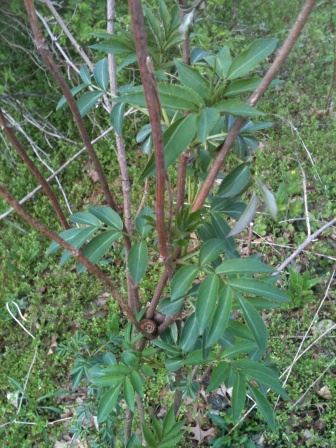
Elder (Sambucus canadensis)
Elder is a mysterious, medicinal, and magical tree said to be inhabited by a spirit, often called "Elda Mohr," or "Frau Hollender," who takes revenge on those who do not respect the elder. To cut or burn elder is thought to be such bad luck that a major road works in England was redesigned when the workers refused to destroy a lush stand of elder. Elder berries are anti-viral. The flowers counter fevers. We will make elder remedies later in the year. Elder does just as well in your garden or by the road as it does in the woods.
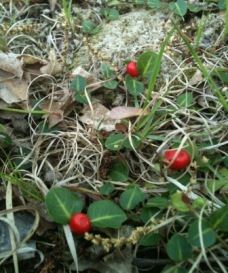
Partridge berry (Mitchella repens)
This creeping plant has a reputation as a medicine plant but is rarely used. I wrote a monograph on it in The United Plant Savers book Saving the Future. The red berries are perfectly safe to eat, though tasteless. Partridge berry is often confused with wintergreen, as they are both small plants with large red berries. The smell is the real identifying mark, which you have to experience in person. Protect this plant.
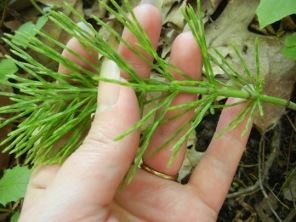
Horsetail (Equisetum arvense)
Horsetail is one of the few non-flowering, non-mushroom plants commonly used by herbalists. My teachers were insistent that it be picked before the end of May, so get out and get it if you are planning to use it this year. Apparently, the silica content gets higher and higher as the plant grows, making the older plants problematic for the kidneys. A pinch of horsetail added to other infusions is said to make the minerals even more active and absorbable.

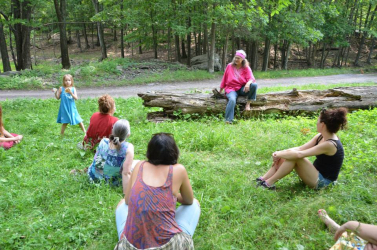 The Wise Woman Center exists to re-weave the healing cloak of the Ancients. This land is sacred, it is a safe space for women, and a place for the teachings of the Wise Woman way. The Goddess lives here, as do goats, fairies, green witches, and elders.
The Wise Woman Center exists to re-weave the healing cloak of the Ancients. This land is sacred, it is a safe space for women, and a place for the teachings of the Wise Woman way. The Goddess lives here, as do goats, fairies, green witches, and elders.



